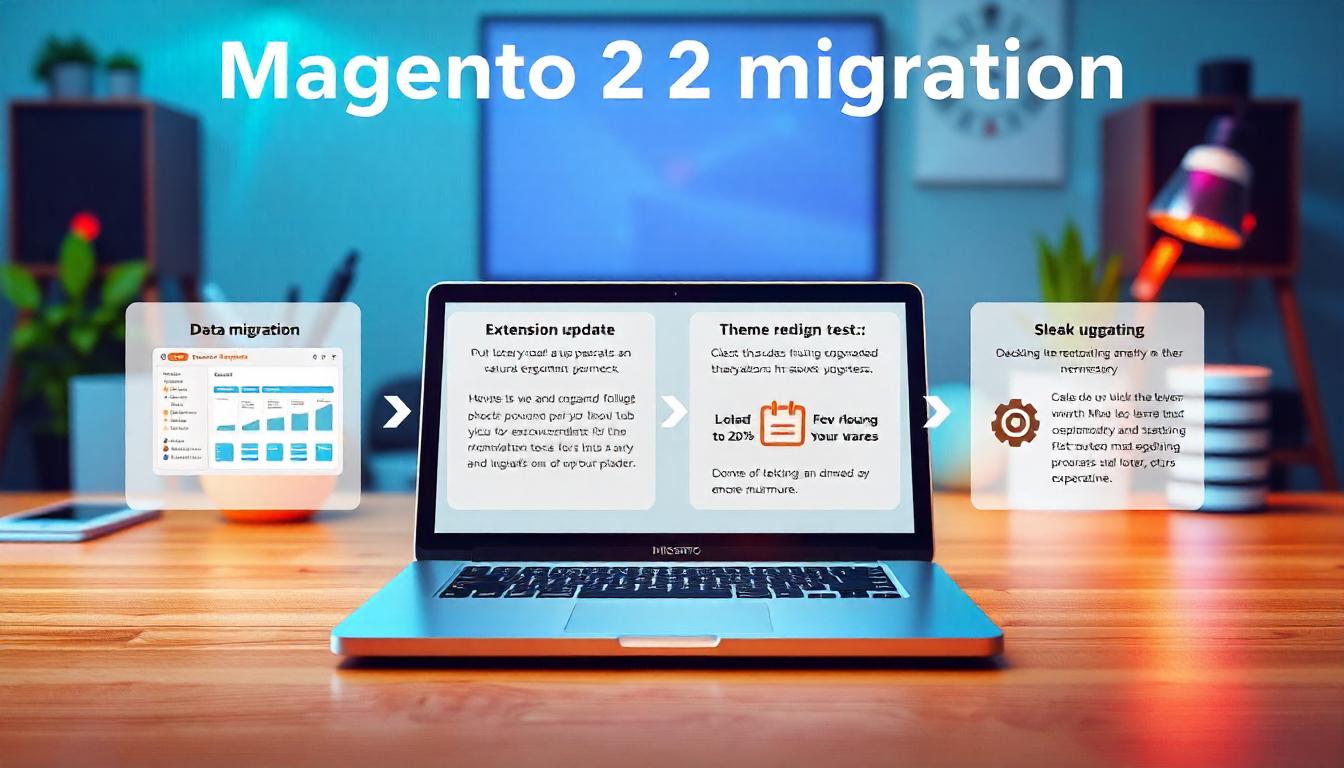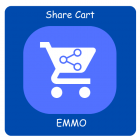Magento 2 Migration: Your Step-by-Step Guide

Magento 2 Migration: Your Step-by-Step Guide
Migrating to Magento 2 enhances your eCommerce store's performance and security. Here's a straightforward guide to help you through the process.
Table Of Content
Why Migrating to Magento 2 is a Smart Choice
Switching to Magento 2 offers significant benefits for online stores. This platform not only improves performance and security but also caters to modern business needs like customizability and mobile-first functionality. Let’s break down why Magento 2 should be on your radar.
Fully Customizable for Your Business Needs
Magento 2 allows complete customization of your store, letting you tailor every detail to your specific requirements. From personalized user experiences to unique design elements, the possibilities are extensive. While custom development can be complex and may require advanced programming skills, Magento 2 simplifies the process with a wide range of extensions. These pre-built modules cover various functionalities, saving time and reducing the need for coding expertise.
Superior Performance and Speed
Performance is critical for online success, and Magento 2 delivers on this front. Its optimized architecture ensures faster page load times, seamless browsing, and a streamlined checkout process. Faster sites not only enhance user experience but also improve conversion rates and search engine rankings. Compared to many competitors, Magento 2 is built to handle high traffic and complex operations without compromising speed.
Robust Security Features
Online stores face increasing cybersecurity threats, making strong security measures essential. Magento 2 proactively addresses these challenges by offering regular security patches and updates. These patches protect against evolving threats, giving both large and small businesses peace of mind. By prioritizing security, Magento 2 helps merchants safeguard customer data and maintain trust, a key factor in eCommerce success.
Designed for Mobile-First Indexing
Google’s mobile-first indexing prioritizes the mobile version of websites for ranking. Magento 2 is built with a mobile-first approach, ensuring that your store runs smoothly across all devices. Considering that 77% of online traffic and 68% of eCommerce sales come from mobile devices (Source: Statista), mobile optimization is no longer optional—it’s essential. With Magento 2, your store can deliver an exceptional shopping experience to mobile users, boosting engagement and sales.
Past Limitations and Why They Matter
Magento 1 users often faced challenges like limited scalability, slower performance, and weaker security. These issues affected sales and user trust. Magento 2 addresses these limitations head-on with modern tools and features that adapt to current market demands.
Moving Forward
Migrating to Magento 2 is not just a technical upgrade—it’s a step toward creating a better shopping experience for your customers. Improved performance, enhanced security, and mobile-first design are just the beginning. Take the leap to future-proof your online store.
Complete Guide to Migrating from Magento 1 to Magento 2
Migrating your online store from Magento 1 to Magento 2 is a crucial step for improving performance, security, and functionality. However, it’s a complex process that requires careful planning and execution. Below is a step-by-step guide to ensure a smooth migration.
Step 1: Assess and Prepare for Migration
Before starting the migration, audit your current store thoroughly. Identify all data, extensions, and custom features to be migrated. This step ensures that nothing critical is overlooked.
- Product Catalog: Review products, attributes, and categories. Decide which data needs to betransferred.
- Customer Data: Ensure seamless migration of order history, preferences, and contact details. Mistakes here can lead to losing customer trust.
- Custom Features: Evaluate third-party extensions or custom code. Determine if updates or replacements are needed for Magento 2.
- Hosting Compatibility: Confirm that your hosting plan supports Magento 2. If not, upgrade your hosting to avoid performance issues.
Step 2: Create a Detailed Migration Plan
With the assessment complete, draft a clear migration plan. Define the data to be migrated, necessary tools, and a timeline.
Plan Checklist:
- Data to migrate (e.g., products, customers, orders).
- Extensions and custom code requirements.
- Migration method: Magento 2 Data Migration Tool, manual migration, or third-party services.
- Address incoming orders during migration to avoid losing data.
Step 3: Migrate Data
Use Magento’s official Data Migration Tool for transferring data like store configurations, payment gateways, and shipping methods. This tool simplifies the migration process but may require adjustments for custom fields.
Incremental Data Migration:
- Use the incremental feature to capture new orders or customer signups during the process.
- Perform a final sync before shutting down Magento 1 to ensure all data is up-to-date.
Step 4: Validate and Test Data
- Product listings, categories, and attributes.
- Customer profiles and order history.
- Storefront functionality (search, cart, and checkout).
After migration, validate the data for accuracy. Test the following:
Step 5: Migrate Extensions and Custom Code
Magento 2 architecture differs significantly from Magento 1, so most extensions need updating or replacing. Check with developers for Magento 2-compatible versions or explore alternatives.
Step 6: Redesign Theme and Optimize
Magento 2 themes require a redesign due to differences in the template system. You can either create a custom theme or choose an SEO-friendly theme from the Magento Marketplace.
Performance Tips:
- Enable full-page caching for faster load times.
- Use WebP images to reduce file size and boost speed.
- Implement a CDN for better performance and reduced server load.
Step 7: Test and Optimize Before Going Live
Before launching your Magento 2 store, test all front-end and back-end operations:
- Product pages, search, and checkout.
- Backend workflows like order management.
Step 8: Launch and Monitor
Choose a low-traffic period for the final migration and launch. Monitor the site post-launch for bugs and address them quickly to minimize disruptions.
Step 9: Train Your Team
Magento 2 is significantly different from Magento 1. Ensure your team is trained to manage the platform effectively.
Tip
To enhance your eCommerce store’s performance with Magento, focus on optimizing site speed by utilizing Emmo themes and extensions. These tools are designed for efficiency, ensuring your website loads quickly and provides a smooth user experience. Start leveraging Emmo's powerful solutions today to boost customer satisfaction and drive sales!
FAQs
What Is Magento 2 Migration?
Magento 2 migration is the process of transferring your store from Magento 1 to Magento 2. This includes moving data, extensions, custom features, and themes while ensuring the new platform is optimized for performance and user experience.
How Should You Prepare for Magento 2 Migration?
Start by auditing your current store. Identify data, extensions, and custom features that need to be migrated. Evaluate your hosting plan to ensure it can handle Magento 2’s resource demands. Create a migration plan with timelines and tools to be used.
What Data Should Be Migrated During Magento 2 Migration?
Key data includes your product catalog, customer information, order history, and store configurations like payment gateways and shipping methods. Use Magento's Data Migration Tool for accurate and seamless data transfer.
What Challenges Can You Face During Data Migration?
Challenges include migrating custom fields, ensuring data accuracy, and transferring incremental data like new orders or customer sign-ups. Always perform a final sync and validate the data after migration to avoid errors.
Can Magento 1 Extensions Work in Magento 2?
No, Magento 1 extensions are not compatible with Magento 2 due to differences in architecture. Look for Magento 2-compatible extensions or consider custom development for essential features.
What Happens to the Store Theme During Migration?
The Magento 1 theme cannot be directly transferred to Magento 2 due to template system differences. You’ll need to redesign the theme or purchase a pre-built Magento 2 theme from the marketplace, which can save time and ensure SEO compatibility.
How Can You Test Your Magento 2 Store After Migration?
Test all store functions, including the frontend (product pages, checkout) and backend operations (order management, admin settings). Address issues before going live to ensure a smooth shopping experience for customers.
What Are Performance Optimization Tips for Magento 2?
Set up full-page caching, optimize images using WebP format, and implement a content delivery network (CDN) for faster loading times. These steps ensure your Magento 2 store runs efficiently.
How Do You Train Your Team for Magento 2?
Magento 2 has a different admin interface than Magento 1. Train your team on new features, admin panel operations, and troubleshooting steps to ensure they are comfortable managing the upgraded store.
When Is the Best Time to Go Live with Magento 2?
Choose a time with low traffic to minimize disruptions. Perform a final data sync before launch, and monitor the store closely for bugs or functionality issues after going live.









